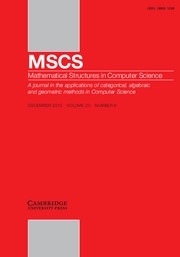Crossref Citations
This article has been cited by the following publications. This list is generated based on data provided by
Crossref.
Kesner, Delia
and
Lengrand, Stéphane
2007.
Resource operators for λ-calculus.
Information and Computation,
Vol. 205,
Issue. 4,
p.
419.
Kesner, Delia
2008.
Automata, Languages and Programming.
Vol. 5126,
Issue. ,
p.
311.
Accattoli, Beniamino
and
Guerrini, Stefano
2009.
Computer Science Logic.
Vol. 5771,
Issue. ,
p.
55.
Tranquilli, Paolo
2009.
Computer Science Logic.
Vol. 5771,
Issue. ,
p.
500.
Kesner, Delia
2009.
A Theory of Explicit Substitutions with Safe and Full Composition.
Logical Methods in Computer Science,
Vol. Volume 5, Issue 3,
Issue. ,
Pagani, Michele
and
Tortora de Falco, Lorenzo
2010.
Strong normalization property for second order linear logic.
Theoretical Computer Science,
Vol. 411,
Issue. 2,
p.
410.
Kesner, Delia
and
Renaud, Fabien
2011.
A prismoid framework for languages with resources.
Theoretical Computer Science,
Vol. 412,
Issue. 37,
p.
4867.
Rose, Kristoffer H.
Bloo, Roel
and
Lang, Frédéric
2012.
On Explicit Substitution with Names.
Journal of Automated Reasoning,
Vol. 49,
Issue. 2,
p.
275.
Accattoli, Beniamino
and
Kesner, Delia
2012.
Preservation of Strong Normalisation modulo permutations for the structural lambda-calculus.
Logical Methods in Computer Science,
Vol. Volume 8, Issue 1,
Issue. ,
Accattoli, Beniamino
2013.
Compressing Polarized Boxes.
p.
428.
Accattoli, Beniamino
2013.
Proof nets and the call-by-value lambda-calculus.
Electronic Proceedings in Theoretical Computer Science,
Vol. 113,
Issue. ,
p.
11.
Accattoli, Beniamino
Barenbaum, Pablo
and
Mazza, Damiano
2014.
Distilling abstract machines.
ACM SIGPLAN Notices,
Vol. 49,
Issue. 9,
p.
363.
Fernandez, M.
and
Siafakas, N.
2014.
Labelled calculi of resources.
Journal of Logic and Computation,
Vol. 24,
Issue. 3,
p.
591.
Accattoli, Beniamino
Barenbaum, Pablo
and
Mazza, Damiano
2014.
Distilling abstract machines.
p.
363.
Accattoli, Beniamino
2015.
Proof nets and the call-by-value λ-calculus.
Theoretical Computer Science,
Vol. 606,
Issue. ,
p.
2.
PAGANI, MICHELE
and
TRANQUILLI, PAOLO
2017.
The conservation theorem for differential nets.
Mathematical Structures in Computer Science,
Vol. 27,
Issue. 6,
p.
939.
Accattoli, Beniamino
2018.
Theoretical Aspects of Computing – ICTAC 2018.
Vol. 11187,
Issue. ,
p.
37.
Kesner, Delia
2022.
A fine-grained computational interpretation of Girard’s intuitionistic proof-nets.
Proceedings of the ACM on Programming Languages,
Vol. 6,
Issue. POPL,
p.
1.


